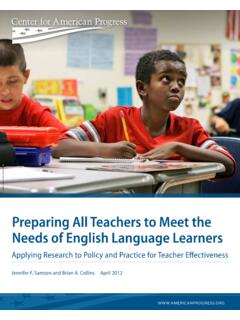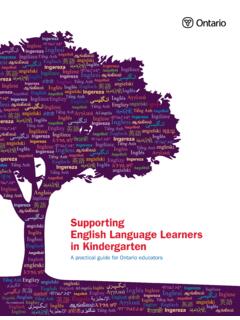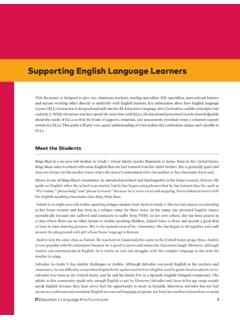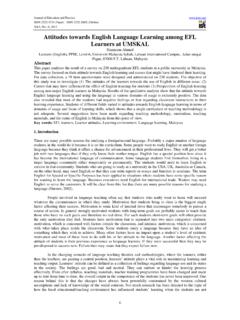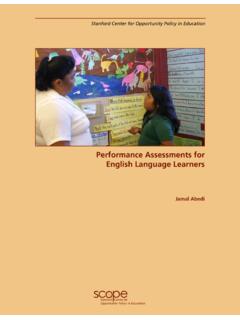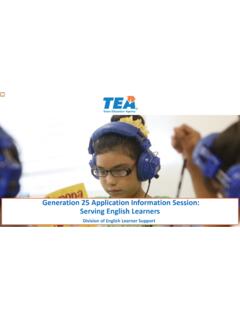Transcription of Strategies for Teaching English Language Learners
1 Strategies for Teaching English Language Learners Introduction English Language Learner (ELL) is an umbrella term to describe students for whom English is not the first Language . ELLs are not a homogeneous group, however, and the needs of all students cannot be met by a simple formula. Some ELLs were born in the United States but live in non- English -speaking households. Others have been in the United States for several years and all their schooling has been in American school. Still others have just arrived in the United States and may be expected to perform in high-stakes testing with little to no English proficiency.
2 In spite of the great diversity of backgrounds and needs of ELLs, classifying students into specific levels of English proficiency can be a useful tool to guide classroom management Strategies and development of modifications to support these students. Though the names for the ELL proficiency levels vary throughout the literature, most sources use five proficiency levels that parallel those described below. The identified proficiency levels are those used by the Teachers of English to Speakers of Other Languages (TESOL).
3 The terms in parentheses represent other commonly use terms for these levels. English Proficiency Levels Proficiency Level Description Starting (Beginning) Student s English vocabulary is extremely limited. In addition to Language challenges, students at this proficiency level may be unfamiliar with the structure and functioning of the American classroom. Emerging (High Beginning) Student s English vocabulary consists of only a few common words or expressions, and knowledge of English academic vocabulary is likely lacking.
4 Students at this English proficiency level may be able to understand more English , such as simple classroom directions, than they can produce. Developing (Intermediate) Student s English vocabulary is growing, and students can generally understand classroom directions and simple questions posed by the teacher. Students at this English proficiency level are typically able to produce simple answers to questions both orally and in writing, though they may lack confidence in using English . Expanding (High Intermediate) Student is approaching English proficiency in everyday Language , and student is developing his or her academic vocabulary.
5 Vocabulary for abstract concepts or terms that have multiple meanings can be a challenge for these students. Bridging (Advanced) Student s English vocabulary is strong, and student can express himself or herself fluently verbally and in writing on popular, personal, and academic topics. Students at this English proficiency level can engage easily with peers who are native speakers, making appropriate use of colloquial and idiomatic expressions. Students may need support in finding opportunities to use English and to further develop their academic vocabulary.
6 Working with ELLs in the Science Content Area Helping ELLs develop their English Language skills is not solely the task of the Language Arts teacher or specialist in English for Speakers of Other Languages (ESOL). Research has shown that the skills required by science inquiry ( , observing, predicting, classifying, communicating, and analyzing) overlap with skills required in Language development ( , ordering, comparing, synthesizing, evaluating). The study of science supports Language development and vice versa.
7 The hands-on and visual nature of much science content at the elementary school level strongly supports development of Language skills as new vocabulary is reinforced through concrete examples and direct experiences. Complex science concepts do require advanced Language skills, particularly at the middle school level and above where science curricula really begin to delve into more micro-scale and abstract concepts. For more abstract concepts, models become critical for supporting ELLs in their understanding.
8 Strategies for Supporting ELLs in the Science Classroom The table below offers general tips and Strategies that teachers can use to support students at different English proficiency levels. One very important idea to remember is that ELLs are not cognitively challenged. Expectations for content understanding should remain high for ELLs. Modifications should focus not on dumbing down the science content, but on allowing students to provide appropriate differentiated responses or to approach the content in different ways.
9 Proficiency Level General Strategies Starting (Beginning) Frame questions in Yes/No format and allow students to respond with thumbs up/thumbs down. Alternatively, you might allow students to use cards of different colors to represent different responses, with students raising the appropriate card to answer questions. , cards for hot/cold, wet/dry, alive/not alive. Use visuals (photos, objects) as much as possible to support explanations of concepts. Acting out explanations dramatically with exaggerated facial expressions and gestures can be very helpful in conveying meaning without relying solely on Language .
10 Permit students to express their understanding through drawings or pantomime supported to the extent possible with one-word explanations. Use a consistent vocabulary and sentence structure both in speaking to students and in written directions. Avoid using words that have multiple or colloquial meanings ( , place, close, fly, hard). Be particularly aware of words that can function as both nouns and verbs (or other parts of speech). Emerging (High Beginning) Use visuals (photos, objects) and pantomime as much as possible to support explanations of concepts.

